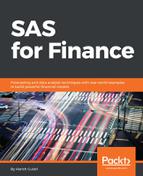This can be simply defined as the amount lost when a counterparty defaults on borrowing. The loss given default (LGD) could be equal to or less than the amount of exposure at the time of default. The LGD percentage will depend on the settlement terms, the collateral available, and the litigation actions that may happen once the customer goes into default.
Let's imagine a scenario where a social media startup has defaulted on a loan of $500,000. The founders had pledged collateral worth $150,000 when availing of the borrowing facility. Let's assume that the value of the pledged collateral is now $200,000. The LGD in this case would be:
The recovery rate in this case is 1-LGD. We have assumed a very simple scenario. Usually, there will be overhead legal, administrative, and other costs involved in trying to recover the amount due or liquidate the collateral pledged.
The LGD could, in rare circumstances, go down below 0% or above 100%. The below 0% situation might arise if the value of the pledged security goes up after default, and the coupons (and so on) linked to the collateral are the property of the lender, as per the borrowing agreement. However, it is very rare for a regulator to allow for a 0% LGD rate assumption. There may be a floor that needs to be assigned to the LGD rate.
